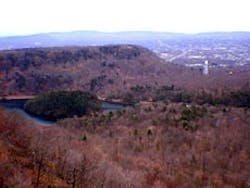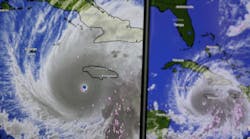Climate Change to Bring Watershed Woes
The Connecticut River Watershed, vital to New England, serves as the primary water supply for greater Boston and a National Fish and Wildlife Refuge for thousands of species of plants and animals. A University of Massachusetts Amherst study has shown that rising temperatures due to climate change will reduce the availability of water during the summer, when demand is the highest, and increase sediment and pollution loads carried by rivers and streams.
“The response of watershed systems is a new area of climate change research, and the U.S. Environmental Protection Agency is calling for proposals to study this issue,” said Timothy Randhir, a professor of natural resources conservation. “With additional funding, I hope to expand this research to the national level.” Graduate student Eric Marshall co-authored the study, which was funded by the U.S. Department of Agriculture.
“Fortunately, sound land use planning can help protect the watershed, including the maintenance of forests in urban areas, reducing loss of open space throughout the watershed and protecting floodplains,” Randhir said. “Low-impact development and smart growth principles can go a long way in our ability to handle climatic impacts. Communities will need to plan for water stress months and implement water conservation practices throughout the year. Water harvesting, along with a network for upland storage, could help manage water resources, and maintaining vegetation along streams will provide a buffer between surface runoff and sensitive streams."
Computer models used to predict changes over the next 40 years showed a decrease in the annual amount of water running off the surface of the land to feed streams and rivers in the watershed, which contains 390 towns and cities and an estimated 2.3 million people. Large changes in the timing of this runoff were also predicted.
Warmer temperatures were predicted to decrease runoff by up to 71 percent in the late summer months of July and August when demand is highest, resulting in reduced stream and river flows that could threaten community water supplies and the production of power at 16 hydroelectric dams located on the Connecticut River. Lower water levels in streams and rivers would mean less water for agriculture and make it more difficult to navigate rivers.
Randhir expects water quality to decrease as surface temperatures rise. Sediment loads carried by rivers and streams were predicted to rise by 50 percent between June and October while the volume of waters receiving the sediment decrease. In addition, changes in the watershed will alter the balance of key nutrients such as nitrogen and phosphorus, resulting in more frequent and intense blooms of algae and increased growth of aquatic plants.
“There will also be less water around to dilute pollutants that wash from the land into rivers and streams, so concentrations of water pollutants are expected to rise,” Randhir said." This effect will be seen all the way to Long Island Sound, and pollution will get worse as you travel down the Connecticut River.”
Storm water systems in urban areas will have to plan for the added sediment and pollution, and greater amounts of sediment will be carried into Long Island Sound, where the Connecticut River meets the sea. Higher sediment loads and pollutant levels could also impact the ability of fish to migrate and place additional stress on aquatic ecosystems.
Source: University of Massachusetts Amherst


